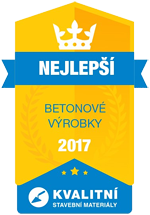Thermal and technical properties of composite structure
Thermal and technical properties of individual layers and complete structures of external walls are described in the tables below. The calculations are based on the ČSN 730540:94 standard, including changes 1:97 Thermal protection of buildings. Thermal resistances and balances of water vapour diffusion and condensation in complete structures are determined using TEPLO 97 software.
The design of these KB-BLOK systém compositions reflects the requirements of Act No. 406/2000 Coll. of 25 October 2000 on Energy Management, the Building Act, Ministry for Regional Development Decree No. 13/1998 Coll. of 9 June 1998 on General Technical Requirements for Construction, and standard ČSN 730540:94.
Based on said standard, the building is required to meet thermal characteristics at the level of so-called recommended values. Apart from the outer envelope, many other structures and factors influence the resulting thermal characteristics of buildings. Therefore, every building has to be evaluated individually. It can be assumed that the thermal resistance limit will be prescribed for individual designs, at least at the level recommended by currently valid ČSN 730540:94. Experience shows that achievement of the recommended thermal characteristics for ordinary buildings requires an outer wall design with an even higher thermal resistance, ensuring a reduction in the heat transfer by about 20%.
Criteria for assessing the thermal resistance for new outer wall compositions of the KB-BLOK systém have been determined based on these requirements.
Standard heat transfer coefficient values
UN required 0.38 W/(m²K)
UN recommended 0.25 W/(m²K)
Thermal resistance of compositions
The calculation of thermal and technical properties of the selected options of outer wall compositions was made using TEPLO 97 software.
The following were entered for the calculation of water vapour condensation and evaporation:
- inner air temperature 21°C
- inner air relative humidity 60%
- outer air temperature -15°C
- outer air relative humidity 84%
Table of resulting values for composite options
| composition | thermal resistance R (m2KW-1) | heat transfer coefficient k Wm-2K-1 | condensed water vapour Gk (kgm-2year-1) | evaporated water vapour Gv (kgm-2year-1) |
|---|---|---|---|---|
| 15-15-15/N | 3.6 | 0.265 | 0.056 | 1.116 |
| 15-15-15/V | 3.44 | 0.274 | no condensation | |
| 20-10-10/N | 2.66 | 0.354 | 0.170 | 0.863 |
| 20-10-10/V | 2.65 | 0.349 | no condensation | |
| 20-10-20/N | 2.8 | 0.337 | 0.066 | 1.357 |
| 20-10-20/V | 2.65 | 0.349 | no condensation | |
| 20-15-15/N | 3.85 | 0.249 | 0.055 | 1.108 |
| 20-15-15/V | 3.47 | 0.272 | no condensation | |
| 30-10-20/N | 2.83 | 0.334 | 0.066 | 1.354 |
| 30-10-20/V | 2.69 | 0.345 | no condensation | |
| 30-15-15/N | 3.89 | 0.247 | 0.055 | 1.107 |
| 30-15-15/V | 3.5 | 0.269 | no condensation | |
| 20-15-KLASIK solid/N | 3.85 | 0.26 | 0.121 | 0.580 |
| 20-15-KLASIK solid/V | 3.71 | 0.27 | no condensation | |
| 20-15-KLASIK hollow/N | 4 | 0.25 | 0.080 | 0.851 |
| 20-15-KLASIK hollow/V | 3.71 | 0.27 | no condensation |
Expanded polystyrene foam (EPPS) with a weight of 20 kg/m-3 is designed for the thermal insulation layer of non-ventilated outer walls.
Stainless steel (lambda '20 Wm-1K-1) is assumed for the steel ties penetrating the thermal insulation layer, with a max. cross section of 6x 4 mm² bars per 1 m² of wall.







